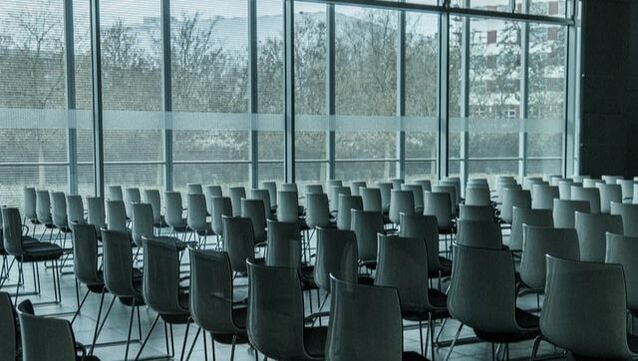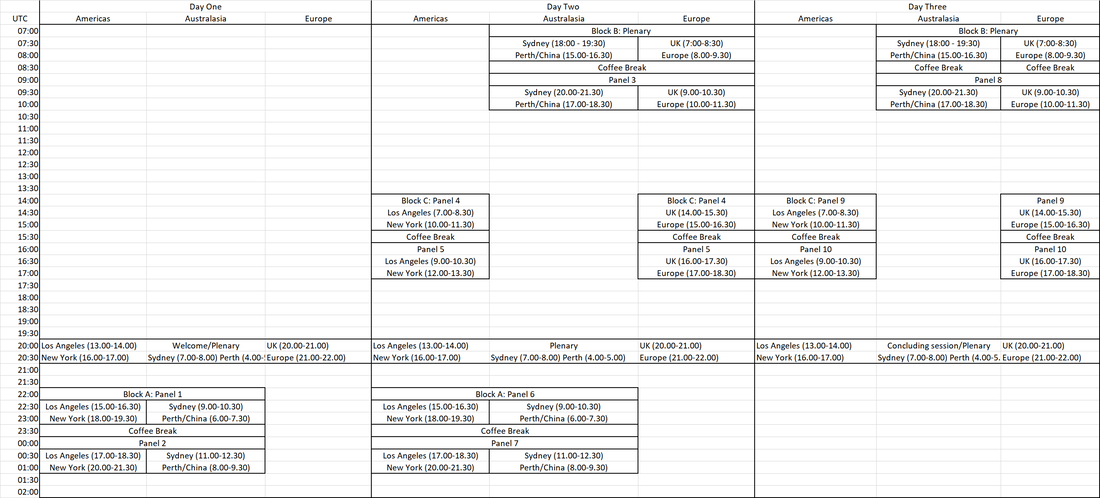|
Planning is continuing for the next Temporal Belongings conference and I thought I'd share the skeleton schedule structure that we have come up with. While it seems like a lot of online conferences are going the asynchronous route - which of course has lots of advantages - we are hoping to contribute a synchronous version to the flying less 'prototyping' many are engaging with. This will mean planning to enable live panel and plenary sessions as much as possible, as well as other networking and social events.
The problem though for an online international conference is how to schedule this so that we can support interaction amongst attendees across the globe. For in person conferences, the fact that many attendees might be expected to be awake during their night hours is something we conveniently ignore, but the move online does away with our ability to overlook this temporal insensitivity. A number of options have been developed to deal with this, including the recent SCA/SVA conference Distribute which ran a pre-recorded programme through three cycles over each conference day. Our approach will build on the timing for our pilot workshop which took advantage of a short time window where our participants in Australia, UK, Norway and Canada could all meet at the same time. We found that meeting synchronously over a few days for shorter slots fit better with our other responsibilities and avoided some of the zoom fatigue that we were already starting to experience in March of this year. Building on these short synchronous sessions for the larger conference we added longer blocks which will enable multiple regions to share synchronous sessions with each other. These are staggered across the day to try to catch different groups as the earth moves through night and day. In addition to the coffee breaks in the middle of the panels, the blocks have larger breaks between them to provide time for catching up on recordings of previous sessions, dealing with other responsibilities, taking a walk, having a rest or socialising with attendees in the open online spaces available.
This image shows our draft two day schedule, with the timings for the UK, Europe, North America and Australasia where the majority of our network members are located, as well as our conference partners. So UK participants could choose from sessions at 7am - 10.30, 14.00-18.30 and 20.00-21.00, while someone on the west coast of Canada and the US would be active 7.00-10.30, 13.00-14.00, 15.00-19.30. Importantly each block enables various geographical overlaps to allow attendees to engage with work from many regions across their day.
Two potential plenary slots are available per day with one bringing together Eastern Australia, the Americas, west Africa and the UK (UTC 20.00-21.00), while the second caters best for nearly everyone except for the Americas including Europe, Africa, the Middle East, and west and east Asia (UTC 7.00-9.30). Our testing of the rest of the schedule so far suggests that all attendees should be able to attend at least three live panels per day relatively comfortably no matter where they are situated. Four or more sessions are also a possiblity, but except for those in the envious UTC-6 & -7 time zones, this often reaches beyond the edges of acceptable conference hours (which were already much more expansive than standard business hours). A silver lining though might be that this is good for those keeping odd hours or others left out of mainstream timing.
Finally, a particular advantage of the platform we will be using - QiQoChat (more on this in another post)- is that attendees will be able to also organise additional sessions at the times that suit them best, as online meeting rooms will be available 24 hours a day for attendees to continue conversations, socialise, organise ad hoc sessions or anything else that takes their fancy. So that's what we have so far - any comments or feedback much appreciated. Comments are closed.
|
Archives
November 2022
Categories
All
|


 RSS Feed
RSS Feed
